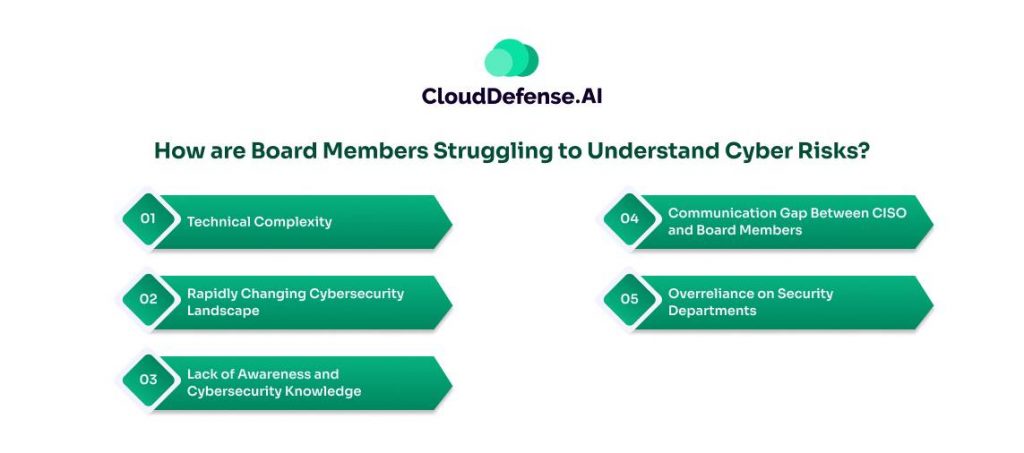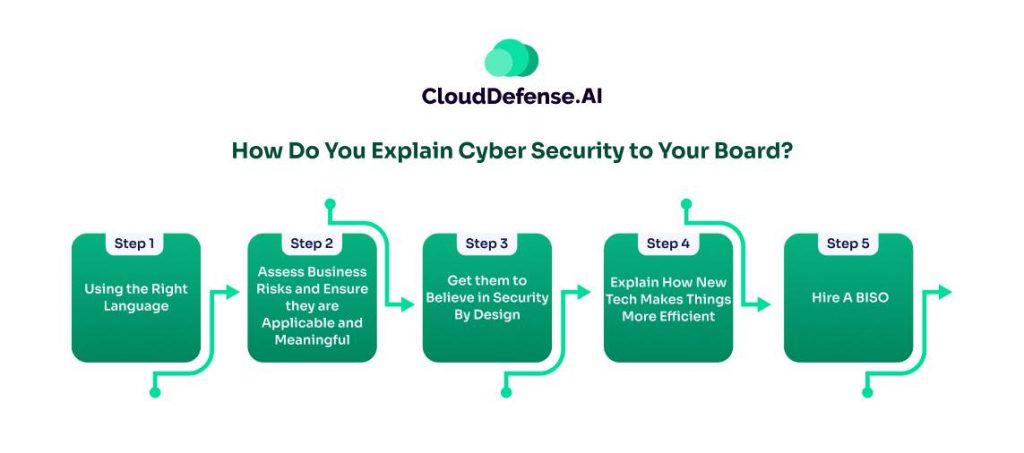What is Member of Board’s Role in Cybersecurity?
The role of board members is evolving, driven by regulatory changes and the evolving threat landscape. Board members must be active in guiding a company’s security strategy. They approve policies aligned with the company’s goals and ensure compliance with regulations. Involved in risk management, they oversee cybersecurity risks and implement mitigation strategies.
Approving budgets for cybersecurity, they stress the importance of funding for technology and training. Board members promote a cybersecurity culture through education, staying informed about threats, monitoring performance metrics, handling third-party risks, and overseeing legal compliance.
Collaboration with executives, especially the CISO, is important for aligning goals. During incidents, board members make key decisions, strategize legally, and communicate with regulators, contributing to the institution’s cyber security infrastructure. The SEC’s new rule says that companies should tell everyone how they handle cybersecurity. This includes what the board does, how management is involved, and what risks they consider.
How Do CISOs Report to the Board?
CISOs are crucial for keeping businesses safe, moving beyond just tech experts. They need freedom, power, and a good position in the company to do their best. Traditionally, they were answerable to CIOs, but that has been reported to cause a conflict of interest.
It’s better when CISOs report to someone higher up, like the CEO, a board member, or a Chief Risk Officer (CRO), who understands and supports cybersecurity. This way, CISOs can work more effectively in protecting the company.
This way of reporting keeps CISOs free from conflicting pressures and helps make cybersecurity part of how the whole company operates. Since executive roles can change, it’s important to be flexible in how CISOs report, letting them focus on keeping the business safe instead of just dealing with costs.
Boards are not Interacting Enough with CISOs
To stay alert to cyber threats, boards pay attention to news about security breaches, as mentioned by Andrew Rose, a CISO at Proofpoint. The survey by Proofpoint points out the main worries for boards, such as the risk of internal data becoming public, damage to their reputation, and loss of money.
Boards in the UK and CISOs don’t always see eye to eye—85% of boards agree on things, but only 65% of CISOs feel the same. Boards look at a wider range of risks, while CISOs focus on their area of expertise. The report highlights that boards play a key role in protecting shareholder investments when it comes to reputation, even though CISOs are more concerned about day-to-day operations.
To be better prepared, Rose recommends practicing for security breaches regularly. Experts also say it’s a good idea to have CISOs on boards for more influence and oversight. Boards should talk regularly with CISOs, build relationships, and stay battle-ready.
How Board Members See Cyber Security?
Most boards see cybersecurity as a technical issue, missing its larger importance for the company and business strategy. The same survey from Harvard Business Review shows that only 67% of board members think human error is their main cybersecurity risk, even though a different study from the World Economic Forum says it’s connected to 95% of incidents.
This indicates a possible neglect of risks to the company. Even though boards discuss cybersecurity, they often see it more as a technical problem than a managerial one. It’s important for boards to change their perspective, realizing that cybersecurity is an important part of their company’s strategy. They should have conversations that focus on security challenges, managing risks, and key strategies for recovery to protect their businesses effectively.
How are Board Members Struggling to Understand Cyber Risks?

Board members find it challenging to understand cyber risks and often struggle in this domain. Recognizing these challenges is critical to improving their participation in cybersecurity efforts.
Technical Complexity
Cybersecurity is a highly technical and rapidly evolving field. Board members, who may not have a background in technology, might find it challenging to grasp the complex details of cyber threats, vulnerabilities, and the technical aspects of security measures.
Rapidly Changing Cybersecurity Landscape
The cybersecurity landscape is dynamic, with new threats emerging regularly. Keeping up with the latest developments and understanding the potential impact on the organization requires continuous learning, which can be challenging for board members who may have other responsibilities.
Lack of Awareness and Cybersecurity Knowledge
Some board members may not fully appreciate the significance of cyber risks or may underestimate the potential impact on the company. This lack of awareness can lead to insufficient prioritization and resource allocation for cybersecurity measures.
Communication Gap Between CISO and Board Members
There can be a communication gap between CISOs and board members. CISOs may use technical jargon that is not easily understandable to those without a technical background. This can hinder effective communication and decision-making.
Overreliance on Security Departments
Some board members may delegate cybersecurity responsibilities entirely to the IT department without actively engaging in discussions about cyber risks. While security professionals play an important role, cybersecurity is a shared responsibility that requires strategic input from the board.
How Do You Explain Cyber Security to Your Board?

By now, you should know that business leaders and tech people often see cybersecurity differently. Some boards view it as a necessary expense, not something that helps make money or improve the business. Even though global spending on security is expected to grow by 11%, boards that aren’t actively involved might spend money on all the wrong measures, leading to poor results.
5 Steps for Getting Board Buy-in on Cybersecurity
To secure your board’s support for your security strategy, follow these five steps to communicate and clarify security concepts effectively.
Step 1: Using the Right Language
When talking to the board about cybersecurity, skip the technical jargon. Instead, mention how it helps the business, reduces risks, and mitigates issues. Show them how a breach can harm the company’s reputation, customer trust, and money. Align your cybersecurity plans with how much risk the company can handle. This way, you can address the board’s worries and show how it all helps the business keep running smoothly and customers happy.
Step 2: Assess Business Risks and Ensure they are Applicable and Meaningful
An essential part of discussing cybersecurity with the board is using simple metrics that show how well security measures work. Keep it easy to understand, and share stories from the company to make your point.
As a cybersecurity leader, show the board the current risks and vulnerabilities, explaining the financial risks and costs of fixing problems. Connect every cybersecurity initiative to financial implications, helping the board make informed decisions based on risk and return on investment.
Step 3: Get them to Believe in Security By Design
Business leaders know cyberattacks are risky but focus more on everyday matters than long-term plans. CISOs need to convince them to prioritize cybersecurity strategically, integrating it into new projects to prevent issues instead of dealing with them later.
Step 4: Explain How New Tech Makes Things More Efficient
When suggesting new cybersecurity investments, show how the tech fits with what’s already in place, creating a strong defense against threats. You can consider checking out the range of tools offered by CloudDefense.AI that are offered as a suite through one platform. Boards tend to agree on effective security solutions that can be accessed through a single suite.
Step 5: Hire A BISO
The Business Information Security Officer, or BISO, connects the business and security teams, turning big plans into practical steps. By emphasizing security in every part of the business, they show skeptical boards the important role it plays.
FAQs
Is CISO a board member?
The Chief Information Security Officer (CISO) is not always a board member by default. While some organizations include the CISO on the board, it varies. CISOs often report to executives and work closely with boards to address cybersecurity concerns and strategies.
What do boards need to know about cybersecurity?
Boards should see cybersecurity as a top priority. It’s important they understand risks, how to respond to incidents, and the changing threat landscape. Getting regular updates on security measures, following rules, and making smart investments helps protect the organization from cyber threats.
What is the board’s role in risk oversight?
The board’s role in risk oversight involves understanding, evaluating, and guiding the organization’s risk management strategies. Boards set risk tolerance, review major risks, and ensure that effective risk mitigation measures are in place to protect the company’s interests and long-term success.
Conclusion
Boards that do not keep a close eye on cybersecurity risk the integrity of their business. Even if they say it’s a priority, they must strengthen their ability to handle cyberattacks. Closing the gap between boards and CISOs is essential. Recognizing the challenges in understanding cyber risks is important as well. It’s vital to shift from seeing cybersecurity only as technical to understanding its strategic importance.
Your board is like the backbone of your organization. If they’re not clued in on crucial matters, such as their company’s security posture, making smart decisions gets tricky. Teach your board about cybersecurity early on. This, in turn, equips your company with the knowledge needed to enhance its resilience against the ever-present security threats in the industry.







